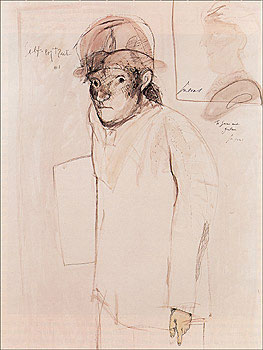José Luis Cuevas
(b. Mexico City, 1934). Cuevas was a painter, draughtsman, and printmaker showed artistic talent as a youth and later briefly attended the Escuela Nacional de Pintura y Escultura 'La Esmeralda' in Mexico City, which he left because he did not agree with its teaching methods; he was thus essentially self-taught. He studied graphic arts at the Institución de Enseñanza Universitaria in Mexico City c. 1948. At the Galleria Prisse in Mexico City he joined a group of young artists, including Enrique Echeverria, Alberto Gironella, Pedro Coronel, Manuel Felguerez and Francisco Icaza who formed a group called La Ruptura, who were opposed to the socialist artists favoured by the Government and whose rebellion against the official mural art was instrumental in modifying the contemporary artistic panorama. Cuevas conducted an aggressive polemic against David Alfaro Siqueiros and his more dogmatic followers, publishing the manifesto 'La cortina de nopal' (Novedades, 1957) where he critiqued the government favoritism of political and populist art. Cuevas' work was influenced by the graphic art of Goya and Picasso as well as by Posada and Orozco, whose representations of deformed creatures, degraded humanity and prostitutes were of particular thematic interest. In this 2001 interview with LatinArt.com, Cuevas speaks of his history as an instrumental player in the history of Mexican modern art and his interest in the occluded subjects of society as models for his most important work.
|







